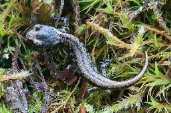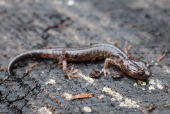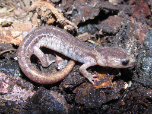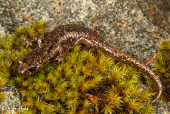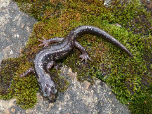Clouded Salamander (Aneides ferreus)
Description: The clouded salamander can grow to about 5 inches total length. It is long and slim with relatively long legs, square ends to its toes and a prehensile tail. It has two naso-labial grooves joining its nostrils to its mouth and sixteen costal grooves down its flank. The upper side is pale grey variously blotched with gold, olive green or dull red. The juvenile has a brass-colored streak down the center of its back.
Habitat: It lives in forested areas favoring moist areas with few trees rather than dry dense stands. It hides under logs and rocks, under loose bark, in rotting logs and in crevices in rock and scree. It particularly favors rotting Douglas-fir logs. It is often common in newly cleared areas with tree stumps and debris.
Range: The clouded salamander is found in the Cascadian bioregion of North America at heights up to 5,600 feet. Its range extends from the Columbia River southwards through the Cascade Mountains, along the Oregon coast to the northern tip of California in Del Norte County.
Found in these States:
CA |
OR
Diet: The clouded salamander feeds on small invertebrates, mainly woodlice, ants and beetles, but also include flies, termites, mites, centipedes, millipedes, spiders and pseudoscorpions.
Reproduction: Breeding takes place in June and July with females laying clutches of nine to seventeen eggs, usually in chambers hollowed out in rotting logs. The larvae develop inside the eggs, emerging as juveniles in about two months, thus bypassing the free-living larval stage. One or both parents may provide care for the eggs before they hatch.
Status: Occurs in coniferous forest/woodland in western Oregon and northern California; occurs in burned areas and tolerates a certain amount of logging; generally most common in forests where there are large decaying logs o the ground, but this resource is increasingly uncommon; current status is not well documented.
»» Kingdom: Animalia - Animals
»» Phylum: Chordata - Chordates
»» Subphylum: Vertebrata - Vertebrates
»» Class: Amphibia - (Amphibians)
»» Order: Caudata - Salamanders
»» Family: Plethodontidae - Lungless Salamanders
»» Genus: Aneides
»» Species: Aneides ferreus - Clouded Salamander
This article uses material from the Wikipedia article "Clouded Salamander", which is released under the Creative Commons Attribution-Share-Alike License 3.0. Content may have been omitted from the original, but no content has been changed or extended.
|


